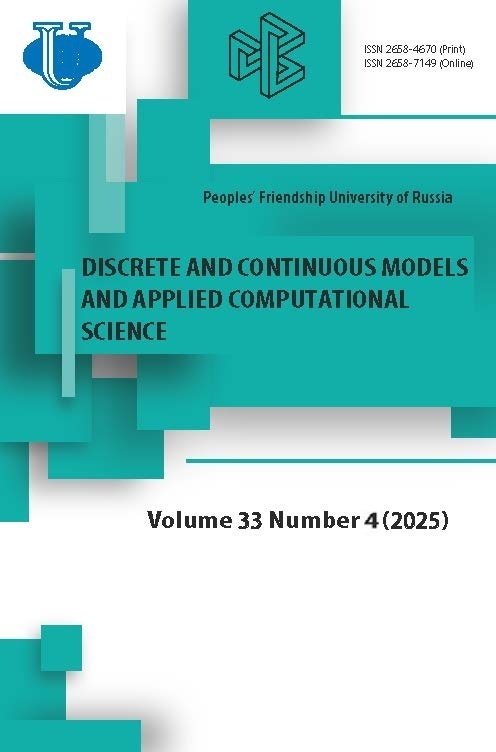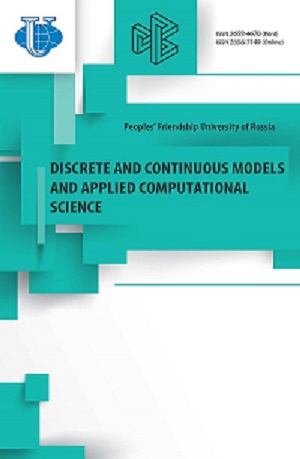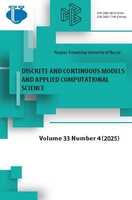Discrete and Continuous Models and Applied Computational Science
Editor-in-Chief: Yuriy P. Rybakov, Doctor of Science (Physics and Mathematics), Professor, Honored Scientist of Russia
ISSN: 2658-4670 (Print). ISSN: 2658-7149 (Online)
Founded in 1993. Publication frequency: quarterly.
Peer-Review: double blind. Publication language: English.
APC: no article processing charge. Open Access: Open Access ![]() , DOAJ SEAL
, DOAJ SEAL ![]()
PUBLISHER: Peoples’ Friendship University of Russia named after Patrice Lumumba (RUDN University)
See the Journal History to get information on previous journal titles.
Indexation: White List, Russian Index of Science Citation, Scopus (Q3 SJR), VINITI RAS, DOAJ, Google Scholar, Ulrich's Periodicals Directory, WorldCat, Cyberleninka, Dimensions, ResearchBib, Lens, Research4Life, JournalTOCs
Discrete and Continuous Models and Applied Computational Science was created in 2019 by renaming RUDN Journal of Mathematics, Information Sciences and Physics. RUDN Journal of Mathematics, Information Sciences and Physics was created in 2006 by combining the series "Physics", "Mathematics", "Applied Mathematics and Computer Science", "Applied Mathematics and Computer Mathematics".
Discussed issues affecting modern problems of physics, mathematical modeling, computer science. The widely discussed issues Teletraffic theory, queuing systems design, software and databases design and development.
Discussed problems in physics related to quantum theory, nuclear physics and elementary particle physics, astrophysics, statistical physics, the theory of gravity, plasma physics and the interaction of electromagnetic fields with matter, radio physics and electronics, nonlinear optics.
Journal has a high qualitative and quantitative indicators. The Editorial Board consists of well-known scientists of world renown, whose works are highly valued and are cited in the scientific community. Articles are indexed in the Russian and foreign databases. Each paper is reviewed by at least two reviewers, the composition of which includes PhDs, are well known in their circles. Author's part of the magazine includes both young scientists, graduate students and talented students, who publish their works, and famous giants of world science.
Subject areas:
- Mathematics
- Modeling and Simulation
- Mathematical Physics
- Computer Science
- Computer Science (miscellaneous)
Current Issue
Vol 33, No 4 (2025)
- Year: 2025
- Articles: 8
- URL: https://journals.rudn.ru/miph/issue/view/1975
- DOI: https://doi.org/10.22363/2658-4670-2025-33-4
Full Issue
Editorial
 355-360
355-360


Computer Science
Leaf disease recognition using deep learning methods
Abstract
The digitalization of crop production has placed leaf-image-based disease recognition among the top research priorities. This paper presents a compact and reproducible system designed for rapid deployment in cloud environments and subsequent adaptation. The proposed approach combines multitask learning (simultaneous prediction of plant species and disease), physiologically motivated channel processing, and error-tolerant data preparation procedures. Experiments were conducted on the New Plant Diseases Dataset (Augmented). To accelerate training, six of the most represented classes were selected, with up to 120 images per class. Images were resized to 192×192 and augmented with geometric and color transformations as well as soft synthetic lesion patches. The ExG greenness index was embedded into the green channel of the input image. The architecture was based on EfficientNet-B0; the proposed HiP²-Net model included two classification heads for disease and species. Training was carried out in two short stages, with partial unfreezing of the base network’s tail in the second stage. Evaluation employed standard metrics, confusion matrices, test-time augmentation, and integrated gradients maps for explainability. On the constructed subset, the multitask HiP²-Net consistently outperformed the frozen baseline model in accuracy and aggregate metrics. Synthetic lesions reduced background sensitivity and improved detection of mild infections, while incorporating ExG enhanced leaf tissue separation under variable lighting. Integrated gradient maps highlighted leaf veins and necrotic spots, strengthening trust in predictions and facilitating expert interpretation. The proposed scheme combines the practicality of cloud deployment with simple, physiology-inspired techniques. Adopting the “species + disease” setup together with ExG preprocessing and soft synthetic lesions improves robustness to lighting, background, and geometric variations, and makes it easier to transfer models to new image collections.
 361-373
361-373


Adaptive neural network method for multidimensional integration in arbitrary subdomains
Abstract
Multidimensional integration is a fundamental problem in computational mathematics with numerous applications in physics, engineering, and data science. Traditional numerical methods such as Gauss–Legendre quadrature [1] and Monte Carlo techniques face significant challenges in high-dimensional spaces due to the curse of dimensionality, often requiring substantial computational resources and suffering from accuracy degradation. This study proposes an adaptive neural network-based method for efficient multidimensional integration over arbitrary subdomains. The approach optimizes training sample composition through a balancing parameter $\rho $, which controls the proportion of points generated via a Metropolis–Hastings inspired method versus uniform sampling. This enables the neural network to effectively capture complex integrand behaviors, particularly in regions with sharp variations. A key innovation of the method is its ``train once, integrate anywhere'' capability: a single neural network trained on a large domain can subsequently compute integrals over any arbitrary subdomain without retraining, significantly reducing computational overhead. Experiments were conducted on three function types---quadratic, Corner Peak, and sine of sum of squares---across dimensions 2D to 6D. Integration accuracy was evaluated using the Correct Digits (CD) metric. Results show that the neural network method achieves comparable or superior accuracy to traditional methods (Gauss–Legendre, Monte Carlo, Halton) for complex functions, while substantially reducing computation time. Optimal $\rho $ ranges were identified: 0.0--0.2 for smooth functions, and 0.3--0.5 for functions with sharp features. In multidimensional scenarios (4D, 6D), the method demonstrates stability at $\rho = 0.2\text {--}0.6$, outperforming stochastic methods though slightly less accurate than Latin hypercube sampling [2]. The proposed method offers a scalable, efficient alternative to classical integration techniques, particularly beneficial in high-dimensional settings and applications requiring repeated integration over varying subdomains.
 374-388
374-388


Modeling and Simulation
Optimal eight-order three-step iterative methods for solving systems of nonlinear equations
Abstract
In this paper, we for the first time propose the extension of optimal eighth-order methods to multidimensional case. It is shown that these extensions maintained the optimality properties of the original methods. The computational efficiency of the proposed methods is compared with that of known methods. Numerical experiments are included to confirm the theoretical results and to demonstrate the efficiency of the methods.
 389-403
389-403


On calculating the dimension of invariant sets of dynamic systems
Abstract
This work investigates numerical approaches for estimating the dimension of invariant sets onto which the trajectories of dynamic systems ``wind'', with a focus on fractal and correlation dimensions. While the classical fractal dimension becomes computationally challenging in spaces of dimension greater than two, the correlation dimension offers a more efficient and scalable alternative. We develop and implement a computational method for evaluating the correlation dimension of large discrete point sets generated by numerical integration of differential equations. An analogy is noted between this approach and the Richardson--Kalitkin method for estimating the error of a numerical method. The method is tested on two representative systems: a conservative system whose orbit lies on a two-dimensional torus, and the Lorenz system, a canonical example of a chaotic flow with a non-integer attractor dimension. In both cases, the estimated correlation dimensions agree with theoretical predictions and previously reported results. The developed software provides an effective tool for analysing invariant manifolds of dynamical systems and is suitable for further studies, including those involving reversible difference schemes and high-dimensional systems.
 404-410
404-410


Dual quaternion representation of points, lines and planes
Abstract
Background. The bulk of the work on dual quaternions is devoted to their application to describe helical motion. Little attention is paid to the representation of points, lines, and planes (primitives) using them. Purpose. It is necessary to consistently present the dual quaternion theory of the representation of primitives and refine the mathematical formalism. Method. It uses the algebra of dual numbers, quaternions and dual quaternions, as well as elements of the theory of screws and sliding vectors. Results. Formulas have been obtained and systematized that use exclusively dual quaternionic operations and notation to solve standard problems of three-dimensional geometry. Conclusions. Dual quaternions can serve as a full-fledged formalism for the algebraic representation of a three-dimensional projective space.
 411-439
411-439


Physics and Astronomy
Simulating QAOA operation using Cirq and qsim quantum frameworks
Abstract
The problem of finding the lowest-energy state in the Ising model with a longitudinal magnetic field is studied for two- and three-dimensional lattices of various sizes using the Quantum Approximate Optimization Algorithm (QAOA). The basis states of the quantum computer register correspond to spin configurations on a spatial lattice, and the Hamiltonian of the model is implemented using a sequence of quantum gates. The average energy value is efficiently measured using the Hadamard test. We simulate the QAOA operation on increasingly complex lattice configurations using the software libraries Cirq and qsim. The results of optimization, obtained using gradient-based and gradient-free methods, demonstrate the superiority of the latter in both modeling performance and quantum computer usage. Key arguments in favor of the advantages of quantum computation for this problem are presented.
 440-460
440-460


Ar-O$_2$ plasma of resonant UHF discharge for chitosan's films processed
Abstract
This article explores the modification of chitosan films by treating Ar-O$_2$ with microwave plasma. The main idea is to use resonant plasma generation methods to treat chitosan films. Spectral and energy characteristics of microwave plasma are obtained. The mechanical properties, swelling, and solubility of chitosan films exposed to microwave plasma are studied. The dependence of film properties on the duration of treatment with resonant microwave plasma is demonstrated.
 461-470
461-470

















